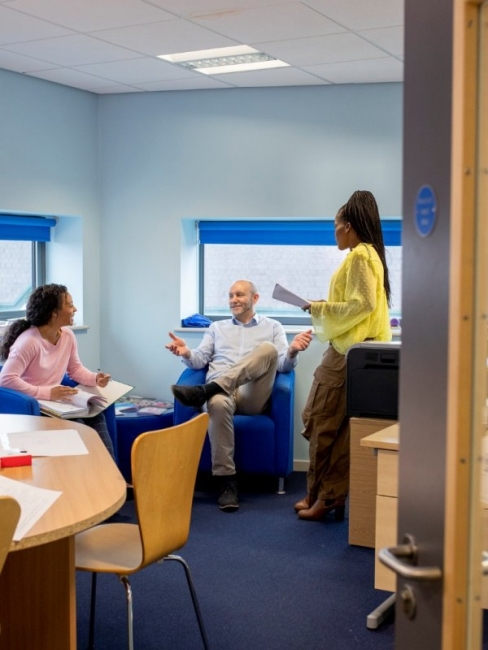You have /5 articles left.
Sign up for a free account or log in.

Istockphoto.com/solstock
Academe’s devolution into online and contingent labor has already caused many changes to the college work environment. One workplace casualty is the old-fashioned faculty lounge, that familiar, shabby oasis of hairy couches and well-thumbed professional journals. This social space no longer comes with the territory of college teaching. Too many overwhelmed brick-and-mortar campuses are hard-pressed to split up existing offices for adjunct hires, retrofitting every spare room -- including supply closets -- with movable file cabinets and cable outlets.
It’s true that the traditional faculty lounge was never a guaranteed respite from simmering departmental tensions, political standoffs, romantic breakups or petty displays of hubris. But it was a space: the space for a humanities professor, who unlike STEM or performing arts faculty lacked a lab or a studio in which to unravel amid peers over a brown-bag lunch.
Having filled nearly all the roles of academe -- graduate teaching assistant, adjunct lecturer, visiting assistant professor, “regular” hire, professor emeritus -- I’ve enjoyed access to faculty lounges intermittently but always with strong impressions. My fondest memories are from graduate school, when the eighth-floor lounge at my university served both doctoral candidates and senior faculty and was the scene of every ritual from obvious coupledom to post-dissertation defense celebration. Later, as a young visiting lecturer at Harvard University, I entered a certain faculty lounge in a male-dominated department to meet a colleague for lunch, only to be asked point-blank by a senior professor just what I was doing there when I was “obviously a student.” (Read: woman.)
During my many years as women’s history faculty at George Washington University, a de facto lounge was the narrow basement “library” of our women’s studies building, a space offering shelter I will never forget on Sept. 11, 2001. That day, all lines between grad student and professor, janitorial employee and program chair, administrative spouse and visiting lecturer, blurred, as one and all huddled around the table to watch televised news of the Pentagon burning just across the bridge from our campus. The lined shelves of books, the files of old graduate theses, the sharp tang of burned coffee fused that room into what it needed to be on Sept. 11: a gathering of insiders both devoted to our students and desperate for a private place to make the unexpected emergency intelligible as swiftly as possible.
In later years, the restructuring of programs and faculty lines, plus heavy reliance on cyberspace for departmental gossip and vitriol, have made lounges obsolete. We miss them. One colleague confided in me that at his own academic conferences, more connections and collaborations are seeded at the bar than in sessions marked for the purpose of networking. This, we agreed, did not signify alcohol dependency as much as the urge to hang out “live” in a designated space, sans laptop.
I awakened to the larger role of the faculty lounge through my recent experience as professor on Semester at Sea, the well-known college program aboard a ship administered by the Institute for Shipboard Education and now academically partnered with Colorado State University. For purposes of our 109-day, 12-port global odyssey, a luxury cruise ship’s dining areas became classrooms. This occasionally felt awkward (e.g., trying to a give lecture on genocide while a cheerful galley crew set out desserts), but in every possible way the ship staff worked tirelessly to create a college campus on the high seas.
In overseeing this undergraduate program, however, the Institute for Shipboard Education at Colorado State introduced another innovation: referring to voyage staff and faculty members by a single term, “staculty.” A cozy bar at the aft of the ship served as a sober work lounge by day and a watering hole after 5 p.m. nightly. In this way, I found other professors preparing lectures or grading papers alongside the dynamic resident directors who oversaw dorm life and the field office staff who booked and facilitated our in-country travel programs. No one was forced to socialize with anyone else (or to drink, it should be made clear). But the equal designation of everyone who had a working role and the intergenerational vibe -- young resident director and faculty spouses, many LGBTQ, plus a cohort of adult learners aboard -- created a faculty lounge beyond my wildest dreams in spring 2019.
Semester at Sea offers the distinctive opportunity to grade papers while watching whales emerge against an Indian Ocean sunset. Yet I spent a large percentage of my hours inside the lounge, pondering my own sheer gratitude at having a social space to enter each day of the voyage. In part, the unusual collegiality of our spring 2019 staculty roster made possible conversations and collaborations that continued night after night. Student behavior certainly dominated the discourse. (For some people, it was their first time living on the same halls as their own students; for me, my third and best voyage.) But the lounge was never an escape from our beloved students as much as a surprising extra voyage to and with trusted colleagues. In this setting, I asked myself (and others): Who else do we wish we could invite into an idealized staculty lounge?
This question preoccupied me through the weeks of teaching and travel. Having immersed myself in daily exchanges with peers from all disciplines, plus younger housing staff, many of whom were completing other advanced degrees, I began to see the cost of lacking a central time and place for all actors in higher education to rub elbows. I’m old enough to fantasize about the faculty lounge awaiting me in heaven (or hell). Do we all have a hand-picked lounge? And if so, who’s in yours? Favorite mentors, irascible campus mail carriers, witty departmental memo writers, rabble-rousers, that photocopy machine repairwoman? Who makes your eyes light up when they stroll in? What if there was never that one lurking, ill-behaved individual but a perfect complement of friends dedicated to the writing life, the life of the mind? Again, this is fantasy. But we actually had it during our time at sea. I saw that it is possible.
Back in the United States after my semester on a ship, I’ve resumed a teaching life where I commute from my home in the woods to a large urban campus some 75 miles away. I do not live where I work, and thus I have less opportunity to run into my own colleagues in town. If I stay late after teaching, it’s with the wisdom that I cannot walk to my home after consuming martinis. This distance is a bargain I’ve accepted as a regional lecturer, able to combine teaching and writing.
The problem is that millions of part-timers just starting careers in academe, or those balancing five or eight adjunct courses with no relief in sight, have no faculty lounge into which they are welcomed as members in the profession -- no campus oasis in which they see their thoughtful faces reflected in a coffeepot or glass. Conversations do spark: through email, Facebook, Instagram. But we ought to recognize each other, in a room. We ought to eat some lunches knee to knee.








